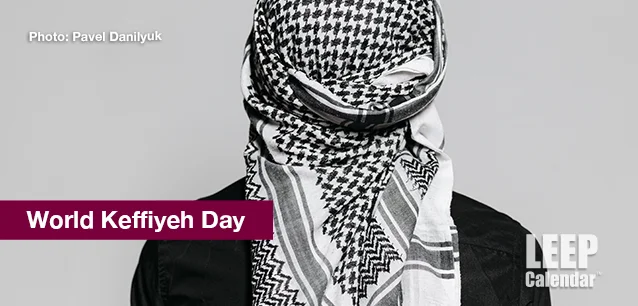 AD
AD
Today is: December 22
Scroll to explore events active on this date.
Additional Events on LEEP
LEEP INK FEATURES

2025 is the Year of...
21 Themes and 'Year of' Events for 2025 PART ONE, THE FIRST 12 Every year, various organizations announce the theme for the year. These themes can focus on causes, such as aesthetics and color tre...

Nuanced November 2024
November is the start of the holiday season in many parts of the world. It is a time for family, football, food, shopping and decorating, particularly in the Christian and Jewish world, leading to Christmas and...

December's Gift
Events in December 2024. Well, we made it to December. December is the holiday season, particularly in Western nations, where Christianity and Judaism are the faiths most common in the nation's past. ...
About World Keffiyeh Day
Culture & Art , Legal
Middle East/West Asia
Ends: May 11, 2025
DESCRIPTION:
ABOUT WORLD KEFFIYEH DAY
World Keffiyeh Day (May 11) and Nakba Day (May 15) demonstrate solidarity with the Palestinian cause and struggle.
WHAT IS A KEFFIYEH?
A keffiyeh (also known as a kufiya, shemagh, or ghutrah) is a centuries-old traditional Arabian scarf worn by men and women. Its appearance differs slightly depending on the region. Black and white tends to be the color chosen in the Levant (Lebanon, Israel, Palestine, Syria).
Red and white or plain white is more common in the Gulf states and North Africa. Versions in beige, blue, and green can also be found; however, these are more recent incarnations and are not specific to a region.
The keffiyeh's pattern resembles the fishing nets and agricultural lands that have fed generations for thousands of years. The scarf is worn by people of all faiths as protection from the sun, wind and sand.
A SYMBOL OF SOLIDARITY, FREEDOM AND CULTURE
Beginning in the late 19th century, prior to the fall of the Ottoman Empire and through the First World War, the keffiyeh became a popular symbol of solidarity for Arabs struggling against colonialism. With the establishment of Israel in 1948, it became associated with the Palestinian people in their struggle against Israel's brutal colonization and subsequent ethnic cleansing of lands not granted to the new state by the United Nations.
KEFFIYEH ENTERS POPULAR CULTURE
In 1967, Israel swept up the rest of the West Bank, Gaza Strip, Golan Heights and the Sinai Peninsula in what became known as the Six-Day War. In the 1980s, the Sinai returned to Egypt, but as the Israeli vise tightened around the Palestinian society now under its occupation, a rebellion known as the First Intifada ("Intifada" is Arabic for "uprising"—nothing more) erupted. Israel, a nuclear superpower, put it down within a year.
Following the First Intifada, PLO leader Yasser Arafat and his consistent donning of a black and white keffiyeh elevated the scarf to its iconic current symbolism of solidarity, human rights and freedom from occupation within Palestinian and Arab society.
Following the October 7, 2023 events, it became more than a utilitarian garment and a symbol of Arab culture and unity. The keffiyeh emerged as an internationally recognized symbol of social justice, anti-apartheid, and a demonstration of solidarity with oppressed people worldwide.
Political interests profiting from occupation and oppression have attempted to associate the pattern, which dates back centuries, with "terrorism."
CONTEXT: WHAT IS THE NAKBA?
Nakba Day is an annual day mourning the displacement and ethnic cleansing of Palestinians (December 1, 1947 - December 31, 1949) from their land of over 4,000 years, preceding and through the state of Israel's declaration of independence in 1948.
Nakba, "catastrophe" in Arabic, is the name given to the first ethnic cleansing of Palestine. During these two years, Israel chose to use terror and military force to expand the land given to it by the United Nations by 300%. It did so through conquest, terrorism and ethnic cleansing.
During the Nakba, the Palestinian inhabitants of dozens of villages were massacred, and hundreds of Palestinian towns and villages were depopulated and razed. In total, an estimated 18,000 Palestinians were killed, and 750,000 temporarily fled or were forcibly expelled. Their stolen homes, businesses and land were either given to incoming Jewish immigrants or renamed and disappeared under newly planted pine forests and agricultural kibbutzim.
VIDEOS
SUPPORTING DOCUMENTS
Currently, this event does not have supporting documents.
ADDITIONAL IMAGES
Currently, this event does not have supporting images.
Where would you like to go now?
 AD
AD


/footer-logo.svg)
